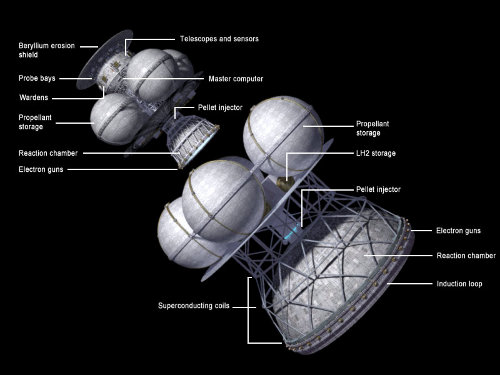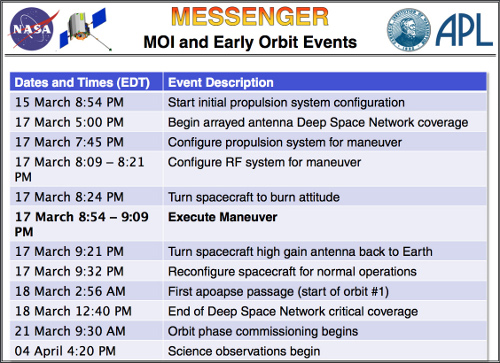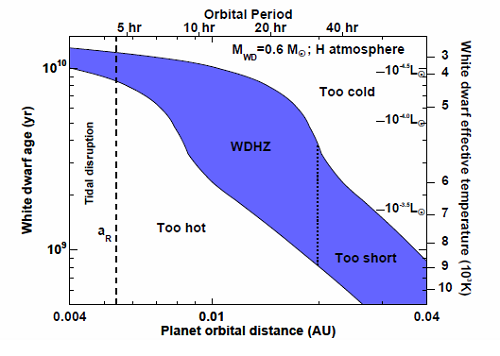Centauri Dreams
Imagining and Planning Interstellar Exploration
Extraterrestrial Life: The Need for an Answer
An article in Time Magazine‘s latest issue caught my eye as I thumbed through it while waiting in line at the grocery store. The magazine is running a feature called ’10 Ideas That Will Change the World,’ and they tend toward being optimistic takes on huge problems. Thus the deficit gets an essay about how we’re going to fix it, while Afghanistan gets a thumbs-up for progress in the right direction. The article finds gold in everything from direct mailings (OK because they help charities raise money) to modern airports, which are creating a new kind of community.
And in the midst of this is a puzzling piece by Jeffrey Kluger called ‘Relax: You Don’t Need to Worry About Meeting E.T.’, where the upshot is: ‘Don’t worry about contact with extraterrestrial civilizations. It will never happen.’ Here’s a quote:
Humans and aliens haven’t connected yet, but with 1022 stars out there (that’s 1 with 22 zeros), it’s just a matter of time — right? Wrong. If exobiologists have learned anything, it’s that you and your kids and their kids’ kids will probably never hear the slightest peep from an alien. If E.T. the movie star is your idea of what extraterrestrial life might be like, you will be disappointed. If your thoughts run more to War of the Worlds, you can breathe easy.
Breathe easy? Let’s assume for a moment that Kluger is right, that contact with an extraterrestrial civilization is simply not going to happen at any time soon or in the future. If we knew that to be the case, would it be a cause for relief? For optimism? Maybe I travel with the wrong crowd, but most of us would be disappointed at the thought that we might never know whether intelligent civilizations exist around other star systems. Even those of us who think a confirmed SETI signal is unlikely any time soon — and I am one of these, believing that intelligent life is extraordinarily rare — would still hope to be proven wrong, and thrilled if we were.
Failure Is Not an Option
Kluger mentions both ‘E.T.’ and ‘War of the Worlds,’ so he’s not just reacting to disaster-oriented invasion films like ‘Battle: Los Angeles.’ The magazine seems to be implying that just the knowledge that we are either alone or unable to communicate with other civilizations is the solution to what Time bills as one of our worst problems. That phrase is used in the lead-in to these ten essays: ‘Our best shots for tackling our worst problems…’, of which knowledge of an alien culture is billed as number three on the list. And I’m wondering, since when is the idea of failing in our attempts to gain scientific knowledge considered the solution to a problem?
The essay goes through the difficulty in finding ETI, including our reliance on a sample of one to construct theories about life’s development on a planet, our uncertainty about how likely life is to develop even on worlds similar to our own, and the difficulty in finding an alien culture through SETI. That last point gets a quote from Don Brownlee (University of Washington), who notes the distances involved in going from star to star in the galaxy and says, “If the nearest hundred or thousand stars don’t have life, we probably won’t ever, ever, ever know about it anywhere else.”
That’s an interesting point if you strip it down to its basic assumptions. Picking up signals from a civilization something like our own would be a hugely difficult proposition even if they were being broadcast from a place as nearby as Centauri B. Pushing the distance out to a thousand light years makes things even more problematic. But we don’t know how long civilizations can exist, and the possibility of one living long enough to be thousands of years — if not millions — more sophisticated than our own can’t be ruled out. The factors that make a chance reception of a signal from a civilization like ours so tricky would be negligible to such an advanced species.
That possibility is one reason why we continue to look. And the fact that we have a sample of just one living planet to base our conclusions about life on is why we continue to look for life elsewhere, to broaden the sample and learn more about life’s mechanisms. So I don’t find any of this convincing in terms of making our detecting an alien civilization less likely to occur.
SETI, Distance and the Odds
But the point about stellar distances is still an interesting one. For one thing, we have a new paper by Joseph Catanzarite and Michael Shao (JPL) analyzing the Kepler science results that attempts to extract an estimate on how common Earth-like planets are. Let me quote from its summary:
Kepler’s science team has determined sizes, surface temperatures, orbit sizes and periods for over a thousand new planet candidates. Here, we show that 1.4% to 2.7% of stars like the Sun are expected to have Earth analog planets, based on the Kepler data release of Feb 2011. The estimate will improve when it is based on the full 3.5 to 6 year Kepler data set. Accurate knowledge of nEarth is necessary to plan future missions that will image and take spectra of Earthlike planets. Our result that Earths are relatively scarce means that a substantial effort will be needed to identify suitable target stars prior to these future missions.
We’re dealing with results that will be improved as the Kepler mission continues, but the figures so far cited indicate that planets like ours aren’t terribly common. Yes, it’s true that even with these low percentages, the option is still open for millions of Earth-like planets throughout the galaxy, given the sheer number of stars involved. But that other big imponderable — the question of how long civilizations last — still faces us. If they don’t tend to survive very long after they develop the ability to destroy themselves through technology, then Brownlee’s point has more resonance. And certainly these numbers say the nearest Earth-like planet may be a substantial distance away, a fact that will make studying it even more challenging than we first thought.
So yes, looking for ETI is difficult. But I can hardly share Kluger’s certainty in Time. He ends the essay, having looked at the possibility of alien extremophiles on Earth, by saying this:
Of course, even such aliens would hardly be the kind we either crave or fear — those who could regale us with tales of what things look like on the other side of the cosmos on the one hand, or conquer us with their superior intellects on the other. Too bad — or maybe very good — you’re never going to see them.
‘Never’ is a curious word to use in the midst of a great scientific investigation, one in which we hope to start assigning some reasonable values to the Drake Equation and find out just where we stand in terms of our place in the galaxy. We know so little, and Kepler and CoRoT are only the beginning of our space-based exploration of exoplanets increasingly like our own. We all have our views on this, and some of us are going to be proven wrong, but our investigations into extraterrestrial life are among the most energizing scientific projects in the history of our species. How could anyone possibly regard a failure to learn the answer as a good thing?
The paper cited above is Catanzarite and Shao, “The Occurrence Rate of Earth Analog Planets Orbiting Sunlike Stars” (preprint).

Equatorial Rains on Titan
Rains have come to the equatorial regions of Titan, a vivid marker of the changing seasons on the distant Saturnian moon. A large storm system appeared in the equatorial regions in late September of last year as spring came to the low latitudes, and extensive clouds followed in October. When they dissipated, the Cassini orbiter was able to capture surface changes in a 500,000 square kilometer region along the southern boundary of the Belet dune field, along with smaller areas nearby, all of which had become darker. The likely cause: Methane rain.
Tony Del Genio (Goddard Institute for Space Sciences) is a member of the Cassini imaging team:
“These outbreaks may be the Titan equivalent of what creates Earth’s tropical rainforest climates,” says Del Genio, “even though the delayed reaction to the change of seasons and the apparently sudden shift is more reminiscent of Earth’s behavior over the tropical oceans than over tropical land areas.”
That’s an interesting take on these observations, because on Earth we find tropical bands of rain clouds year round in equatorial regions. On Titan, the evidence so far is telling us that extensive bands of clouds may occur in the tropics only during the equinoxes, bringing rain to what had been equatorial deserts. In fact, we’ve seen years of dry weather in the Titanian tropics, but now Cassini is showing us an area the size of Arizona and New Mexico combined that shows clear signs of saturation through a presumed methane rainfall that lasted several weeks.
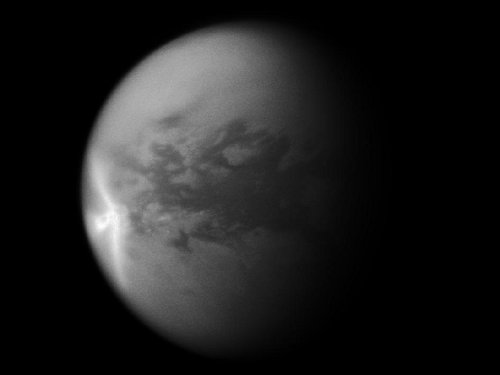
Image: A huge arrow-shaped storm blows across the equatorial region of Titan in this image from NASA’s Cassini spacecraft, chronicling the seasonal weather changes on Saturn’s largest moon. This storm created large effects in the form of dark — likely wet — areas on the surface of the moon, visible in later images. After this storm dissipated, Cassini observed significant changes on Titan’s surface at the southern boundary of the dune field named Belet. The part of the storm that is visible here measures 1,200 kilometers (750 miles) in length east-to-west. The wings of the storm that trail off to the northwest and southwest from the easternmost point of the storm are each 1,500 kilometers (930 miles) long. Credit: NASA/JPL/SSI.
The changes in Titan’s weather over time are strikingly well defined. During the moon’s late southern summer back in 2004, major cloud systems were associated with its south polar region. The clouds seen in the 2010 imagery of the equatorial regions appeared one year after the August, 2009 equinox, when the Sun moved directly over the equator. The suggestion in this new work on Cassini data, which appears in Science, is that the global atmospheric circulation here is influenced both by the atmosphere and the surface, with the temperature of the surface responding more rapidly to changes in illumination than the thick atmosphere.
Thus we see Titan reacting to a change of seasons, though in delayed fashion, with an abrupt shift in cloud patterns that is reminiscent of what happens on Earth over tropical oceans rather than tropical land areas. Given these observations, the dry channels Cassini has seen in Titan’s low latitudes are likely caused by seasonal rainfall rather than being the remnants of a past, wetter era on the moon. Until this point in the Cassini mission, we had seen liquid hydrocarbons like methane and ethane only in the polar lakes of Titan, while the dunes of the equatorial regions were arid. Says Elizabeth Turtle (JHU/APL), lead author of the paper on this work:
“It’s amazing to be watching such familiar activity as rainstorms and seasonal changes in weather patterns on a distant, icy satellite. These observations are helping us to understand how Titan works as a system, as well as similar processes on our own planet.”
The paper is Turtle et al., “Rapid and Extensive Surface Changes Near Titan’s Equator: Evidence of April Showers,” Science Vol. 331, No. 6023 (18 March 2011), pp. 1393-1394 (abstract).

Deadline Reminders: NASA Solicitations
Tau Zero practitioners should be aware that deadlines on the following solicitations are approaching quickly:
(1) NASA Innovative Advanced Concepts (NIAC) – Early Stage Innovation
DEADLINE for Notices of Intent: 29-March-2011
(Just 7 workdays away)
DEADLINE for Proposals: 02-May-2011
(2) NASA Broad Agency Announcement (BAA): Technology Demonstration Missions (TDM)
DEADLINE for Notices of Intent: 31-March-2011
(Just 9 workdays away)
DEADLINE for Proposals: 31-May-2011
(3) NASA Broad Agency Announcement (BAA): Unique and Innovative Space Technology
DEADLINE for Exec Summary: 30-Sept-2011
DEADLINE for White Paper: 01-Nov-2011
DEADLINE for Proposal: 03-Jan-2012

The Flight of Icarus: Abridged
by Andreas Tziolas
After a 15 minute main thruster burn early this morning (UTC), the MESSENGER spacecraft is now in orbit around Mercury. Congratulations to the entire MESSENGER team. As we look forward to much more from Mercury, I want to turn today’s session over to Andreas Tziolas, for some thoughts on the mind-bending process of designing an interstellar spacecraft. Dr. Tziolas is a theoretical physicist and spacecraft engineer, currently serving as the Deputy Project Leader of Project Icarus. In his recent PhD (2009), he explored cosmologies resulting from brane collisions in string theory. He is currently the chief scientist for Variance Dynamical, an electronics prototyping company in Anchorage, Alaska developing radiation hardened electronics for use in space exploration. In this article, Dr. Tziolas talks to us about the legend of Icarus and offers some personal reflections from his experience as a part of the inspirational Project Icarus design team.

There have been many projects and collaborations inspired by the dramatic flight of Icarus. A young boy adorns wings made of sticks and wax to soar to the heavens together with his father, Daedalus. As legend would have it, the young boy elated by the sensation of flight decides to push the limits of his father’s creation and, ignoring his warnings, flies higher and higher until the Sun’s radiant beams melt the wax with which his wings were held together and he falls helpless to the ocean, never to be seen again.
The story is quite tragic and brief. There is no need for eloquence in conveying it, nor have I ever searched out the complete telling of the tale. For one I have never felt the need to, perhaps because any retelling would only contradict and confuse its personal meaning to me. I believe it’s a tale of a boy that looked up to his father, an accomplished scientist who managed to fulfill man’s ageless dream of flying. Young Icarus must have grown up carefully observing his parents thinking how one day, he will surpass them, make them proud, go further and higher than they ever could. And so he did.
The tale is then a story of a young man coming of age. In that all important moment of revolt, he disobeys his father and pushes ahead, a man now, flying far above his father, ever climbing higher and higher, tasting freedom and independence as he climbed to touch the Sun. I believe Icarus would have kept on going until he found a new sky, far up and into space where he may have paused to regard the stars before returning to Earth to tell his father all about it.
Pushing Past the Boundaries
Having been part of Project Icarus since its inception, I have come to realize how many of our designers share the spirit of this young boy of legend. We may not all have the genius of our father, Daedalus but we are intent to push the boundaries of science and technology to make a contemporary plausible reference design from which humanity might one day construct the vessel to voyage to the stars. Like so many others, we stand on the shoulder of giants – the inspirational Project Daedalus team, who were the first to piece together the sticks and rope and wax wings – to show us how the seemingly impossible was merely difficult. The British Interplanetary Society has the richest history, amongst all space organizations ever, for supporting those ideas which matter – the ideas which inspire. We are proud to be descended from that same house.
Image: The Project Daedalus design, as developed by the British Interplanetary Society in the 1970’s. Credit: Adrian Mann.
I feel fortunate that my path in life led me to being a part of this project; to have become a physicist, inspired by all those science fiction movies and books and to have made some small contribution to science. I have also seen, with great disappointment, those sometimes more capable than me, move away from that which inspired them – sometimes even looking down with contempt at notions of starships, planetary terraforming and faster-than-light travel. Somewhere along the way that special fire went out, perhaps because it seemed too difficult or science did not yet have the faculty to clearly provide a path towards such accomplishments.
So now a group of volunteers decide to hoist themselves up onto the shoulders of those intellectual giants and take on the most challenging of space endeavors. Designing a starship is difficult business. Managing a team of international volunteers and keeping the project on track is, as it turns out, a fairly interesting story in itself.
Making Icarus Happen
First and foremost, we are all volunteers which means of course we are not being paid for our work. The amazing consensus amongst the team however, is that any contribution we make towards advancing mankind to the stars is sufficient reward. As such we have come to expect the highest quality of scientific work from each other which is ensured through a rigorous internal review process. Trade studies, research notes and papers are first published internally and are subject to the highest level of academic and professional scrutiny.
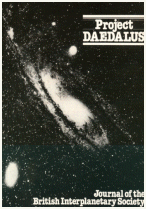
In this process disagreements are a natural occurrence, the resolution of which is usually orchestrated by the Project Leader (PL), the Deputy Project Leader (DPL) and the Core Design Team, which is comprised of those who have proven their worth to their team through their dedication and quality of work. In other research organizations, conflicts are resolved either by deferring to a higher authority or by an appropriate democratic process and vote. In Project Icarus neither are appropriate, since volunteers can neither be fired, nor disciplined since any work contributed has been done with significant personal investment. The democratic method is also meaningless, since a panel of experts in interstellar engineering would be required, which doesn’t exist anywhere in the world. It would seem that Project Icarus has reinvented an almost forgotten process of conflict resolution, which is done through respect and reason. Discussions are respectfully conducted at all times, the resolution of which relies solely on what is reasonable. These reasonable technical decisions are steering the design process towards a plausible spacecraft design which is essential to establishing our credibility.
And what about motivation? How do you motivate someone to get cracking and study up on the latest antimatter confinement paper, when he or she already works full time and has a family? It is indeed very difficult. Project and Module Leaders must frequently remind designers of deadlines for finishing studies and ask for progress reports. Team performance is tabulated and monitored for studies which are potentially falling behind. Emails to delinquents are written in a strange tone which somehow combines appreciation for work promised and freely offered with the resounding crack of the whip.
Sometimes management is management, even in Project Icarus, but for the most part yet another fascinating phenomenon tends to align the team with our research objectives. You see, everyone on the team is a scientist of sorts. OK, so yes, everyone is one or another sort of geek. Some are computer geeks, others technology geeks, sci-fi geeks, rocketry geeks, etc, etc the list goes on. On occasion designers will come across something loosely related to an Icarus research study topic while reading their favorite geek-blog and email it to the rest of the team. From the commentary that follows, ideas are formulated which are slowly technically justified and extended resulting in our designers getting excited and motivated. An all important side-effect of this process is that the entire team stays informed of the latest scientific developments, beyond the capacity of any one geek.
Growth of the Project
In the last year, Project Icarus has been steadily growing in popularity through our presentations at conferences in Europe and the USA, paper publications and through articles appearing in scientific magazines and notable websites such as the Discovery Channel. I have noticed that every time we appear in the press, the team rejoices and their research efforts are invigorated. In a sense, this exposure justifies the long hours of work that is being poured into the project.
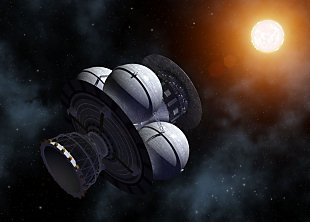
I know for a fact several of our designers are people that have been working on the problem of interstellar flight for many years, training themselves by carefully monitoring technological innovations and scientific articles for small pieces of the puzzle. For most of us, not lucky enough to be working for NASA or a distinguished university with a space research group, we are still left with that feeling of looking in from the window, regardless of how many papers we read on Magnetic Confinement Fusion in our free time. Project Icarus is a home, or a docking station if you will, to all those dedicated thinkers.
Image: Daedalus arrives at its target, Barnard’s Star. Credit: Adrian Mann.
There are certainly many many other organizations inspired by space out there, like the Mars Society for instance, but that’s Bob Zubrin’s dream. Wouldn’t it be nice to join a group of like minded people who like you, are willing to put 5 years of concerted effort into designing a starship or a lunar research station or a space elevator? Sure there are some aspiring companies out there which have worked hard to get funded to do that kind of research, but they don’t have to be the only ones.
In the same way we create our man-caves and mom-caves – our little corners of heaven in our garage where we can work on small but fulfilling microelectronics or woodworking projects, we could also band together, get organized and allow ourselves to become a cog in a great machine that builds dreams out of science. I wonder what the world would look like if we all got up in the morning and went to our regular jobs in our offices and worksites, came home, had some dinner, watched some TV, played with the kids and then sat down in front of the computer to work on the designs of a starship or satellite. This is not the first time someone had this idea, nor am I saying that this is something new. Wikipedia was built from the community and a truly excellent job has been done. Others are now finding ways to motivate what are being called “crowd-sourcing” projects, where the content is built up from users.
The Real Ending of the Icarus Story
Icarus flew towards the Sun and burned his wings and now Project Icarus is designing a starship to fly to a nearby Star. “What an unfortunate choice of name!”, most people tell us. Maybe I watch too many movies, but I don’t believe the legend is complete and that there is more to the tale of Icarus, either lost through the ages or just waiting for ages to be told.
I believe that, like so many heroes that fall off of cliffs and fall into the ocean, Icarus was not lost at sea after his long fall from touching the Sun. Icarus came to on the shore of a Greek beach, exhausted and confused. After searching through the sky for his father for many days and nights, he took pause and collected himself. He started a fire and found he had melted the sand into glass and that the soft clay had become rock. After studying these carefully, he saw the future unfolding and understood his destiny. He meticulously collected materials to slowly build himself a better set of wings made of fabric and steel, working day and night under the hot sun. He did not tire or lose confidence, for he had had the best of teachers, his father Daedalus. And he would not be repeating his mistakes.
If anyone reading this feels motivated, then please feel free to contact Project Icarus. We have a lot of work to be done and we are in need of competent scientists. We believe that everyone brings something new to the project and the least you will get in return is a profound kinship, a thirst for learning and an interstellar starship with a good name.
White Dwarfs and Habitable Planets
Before I get into today’s story, which is an interesting study on planets around white dwarfs that Andrew Tribick passed along, I want to say a few words about Japan. Centauri Dreams has many, many readers in that country, and the terrible images and stories coming out of there have haunted me these past few days. The suffering of those displaced by the earthquake and tsunami, and the continued problems in resolving the worsening situation at Fukushima, make it hard to focus on any other topic. Speaking for myself here at Centauri Dreams — and I know I speak for the entire Tau Zero Foundation as well — you Japanese readers remain in our thoughts and prayers, and will continue to do so until these great national wounds are healed.
On the space front, today is the day when MESSENGER enters Mercury orbit. Below is the schedule for the events, which we’ll follow closely as orbital insertion occurs.
White Dwarfs and Potential Planets
But for now let’s talk about white dwarfs, those interesting survivors of Sun-like stars that have gone through the red giant phase and presumably swallowed up planets within roughly Earth’s distance from the Sun. An interesting paper from Eric Agol (University of Washington) takes a look at exoplanet possibilities around white dwarfs, and draws some surprising conclusions. We have, of course, searched for habitable planets primarily around stars that are much younger, assuming that a planetary system that had undergone the transformation of a red giant into a white dwarf would be unlikely to provide a suitable home for life. But Agol isn’t so sure.
Remember the process: Stars like the Sun eventually exhaust their nuclear fuel and at some point lose their outer envelope, leaving only the hot core behind. The core, now a hot white dwarf at temperatures exceeding 100,000 Kelvin, will begin a long process of cooling. A typical white dwarf might be half as massive as the Sun, but not much larger than the Earth in size, and as this NASA article points out, that means it’s extremely dense, perhaps 200,000 times as dense as the Earth itself. When it comes to matter, only neutron stars surpass that density.
Agol points out that the most common white dwarfs have surface temperatures in the range of 5000 K, which leads to his calculation that a planet would need to orbit no closer than about 0.01 AU to be at a temperature where liquid water could exist on the surface. What’s intriguing from the standpoint of finding such planets is that a potentially habitable world like this, Earth-sized or even smaller, would in principle be detectable because of the small size of the host star. The white dwarf, in fact, could be completely eclipsed by a habitable planet that orbits it.
But how does a planet survive the preceding red giant phase? One possibility is that new planets could form out of gases near the white dwarf, especially in binary systems where gravitational interactions could play a helpful role. We know of two neutron stars that have planets that conceivably formed from the disk created after a supernova event. Moreover, the pulsar 4U 0142+61 has been shown to have a circumstellar disk thought to have been formed from supernova debris. Planetary capture or migration can’t be ruled out, either.
Defining a Habitable Zone
I’m going to post Agol’s chart on white dwarf habitable zones (WDHZ) below to illuminate what he has to say. Here the habitable zone is plotted against time as a blue-shaded region, and because the white dwarf is cooling, the region shrinks with time. The planet starts off too hot for liquid water, passes through the white dwarf habitable zone, and then becomes too cold for life.
Image: The WDHZ for MWD = 0.6M? vs. white dwarf age and planet orbital distance. Blue region denotes the WDHZ. Dashed line is Roche limit for Earth-density planets. Planets to right of dotted line are in the WDHZ for less than 3 Gyr. Planet orbital period is indicated on the top axis; white dwarf effective temperature on the right axis. Luminosity of the white dwarf at different ages are indicated on right. Credit: Eric Agol.
Using the WDHZ limits, Agol defines a ‘continuously habitable zone’ (CHZ) as a range of orbital distances habitable for a minimum duration. Choosing a minimum duration of 3 billion years produces a continuous habitable zone within 0.02 AU, so we have a three billion year period for the development of life at that distance. The author comments on the consequences:
…the range of white dwarf temperatures in the portion of the CHZ within the WDHZ is that of cool white dwarfs, ? 3000–9000 K (right hand axis in Fig. 1), similar to the Sun. At the hotter end higher ultraviolet flux might affect the retention of an atmosphere, these planets would need to form a secondary atmosphere, as occurred on Earth. Excluding higher temperature white dwarfs only slightly modifies the CHZ since they spend little time at high temperature. Cool white dwarfs are photometrically stable…, which is critical for finding planets around them.
Finding a White Dwarf Planet
An interesting prospect indeed, one that Agol further explores by simulating sky surveys that could find such planets. Among the latter calculations, it’s interesting to note that the GAIA mission will observe 200,000 disk white dwarfs between 50 and 100 times each, making the detection of a white dwarf with a habitable planet a real possibility. Even more likely are the prospects for the Large Synoptic Survey Telescope, a planned wide-field survey in Chile.
And what would life be like on a planet orbiting in the habitable zone of a white dwarf?
The most common white dwarf has Teff [effective temperature] ? 5000 K, close to that of the Sun; consequently, inhabitants of a planet in the CHZ will see their star as a similar angular size and color as we see our Sun. The orbital and spin period of planets in the CHZ are similar to a day, causing Coriolis and thermal forces similar to Earth. The night sides of these planets will be warmed by advection of heat from their day sides if a cold-trap is avoided… Transit probabilities of habitable planets are similar for cool white dwarfs and Sun-like stars, but the white dwarf planets can be found using ground-based telescopes… at a much less expensive price than space-based planet-survey telescopes.
This is a provocative paper, one that jolts us into thinking about habitable zones in places where we hadn’t thought of looking before. Yet as we’re finding in our exoplanet research, the universe keeps yielding surprises, and a habitable planet around a white dwarf may not be so bizarre after all. Does anyone know of any science fiction writers who have tackled such a scenario? If so, do let me know. Agol’s paper is “Transit Surveys for Earths in the Habitable Zones of White Dwarfs,” in press at the Astrophysical Journal Letters and available as a preprint.
Addendum: See the comments below for a link to a discussion of white dwarf planets that I was hitherto unaware of.

MESSENGER’s Day in the Sun
We rarely talk about the inner planets here, and even Mars gets short shrift. That’s because I decided at the outset that because there were so many excellent sites covering planetary exploration — and especially Mars — my only focus within our Solar System would be on the outer planets and, of course, what lies beyond them. But the MESSENGER mission is simply too fascinating to ignore, the first mission to Mercury since Mariner 10 way back in 1974, and beyond that, one of its project scientists is a man I deeply respect, Ralph McNutt (JHU/APL), who in addition to his MESSENGER duties also serves as one of the consultants for the Project Icarus starship design.
In fact, McNutt’s work in regions both near and far from the Sun is voluminous. For MESSENGER, he will be analyzing the planet’s surface composition using data from the spacecraft’s X-Ray Spectrometer and Gamma-Ray and Neutron Spectrometer instruments. But he’s also a co-investigator for the New Horizons mission to Pluto/Charon, works with the Cassini team on the Ion Neutral Mass Spectrometer investigation, acts as a science team member for the Voyager probes, and is actively involved in interstellar probe design, as witness his work on the Innovative Interstellar Explorer mission, a near-term precursor probe to 200 AU.
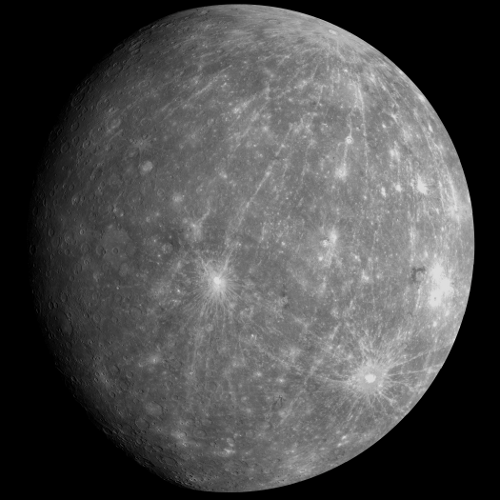
Image: This high-resolution mosaic of NAC images shows Mercury as it appeared to MESSENGER as the spacecraft departed the planet after the mission’s second flyby of Mercury. This mosaic resembles one of the first images received back at Earth following that flyby, an image that showed for the first time the spectacular rays of Hokusai crater extending great distances across Mercury’s surface. Credit: NASA/Johns Hopkins University Applied Physics Laboratory/Carnegie Institution of Washington.
MESSENGER is set to achieve Mercury orbit after a 4.7 billion mile trip that has included fully fifteen trips around the Sun and six planetary flybys. Orbital insertion should be around 0100 UTC on the 18th, marking the first time a spacecraft has orbited the planet. It’s been a long journey not only in miles but in time since MESSENGER launched more than six and a half years ago. Ahead is a year-long science mission as MESSENGER orbits the barren world in an orbit that closes to within 200 kilometers of the planet’s surface. Says APL’s Eric Finnegan:
“For the first two weeks of orbit, we’ll be focused on ensuring that the spacecraft systems are all working well in Mercury’s harsh thermal environment. Starting on March 23 the instruments will be turned on and checked out, and on April 4 the science phase of the mission will begin and the first orbital science data from Mercury will be returned.”
Remember that Mariner 10’s images of Mercury’s surface were made during three flyby maneuvers in 1974 and 1975, but the spacecraft could only send us pictures of one side of the planet. MESSENGER has been filling in the gaps through its own flybys, and now we’ll complete the picture. What’s exciting isn’t just the thrill of making a full study of a little-examined world, but knowing that the more we learn about the geological history, surface composition and other salient facts about Mercury, the more we learn about rocky planets in general, knowledge which we’ll apply as we try to make sense out of the smaller worlds we find around other stars.
Coping with heat will be a major issue for this mission, which is why the spacecraft’s instruments are shielded against the reflection from the planet’s surface. Thermal issues have consequences for the spacecraft’s orbit as well, says Ann Sprague (University of Arizona):
“The spacecraft is going to go very fast, traveling around the planet every 12 hours. The orbit is highly elliptical to allow the spacecraft to cool down. We couldn’t do this with a circular orbit, like around Mars. Everything would just overheat. MESSENGER must swoop in, keeping its sunshade pointed toward the Sun, and then it has to swing out far into space so it can cool down.”
We have much to learn, including the question of whether frozen water may be found beneath dust layers in the permanently shadowed crater bottoms at the poles, the nature of the planet’s exosphere (a thin region of atoms and ions generated by charged particles from the solar wind striking the surface and interacting with elements there), and the question of Mercury’s magnetic field. The planet is small enough (not much larger than the Moon) that it should have solidifed to the core, as this UA news release points out. But the presence of a magnetic field tells us that there may be molten material inside, generating a field MESSENGER will examine closely.
All of this reminds me that Mariner 10’s Mercury travels had ramifications in unexpected ways. Flaking paint from the spacecraft’s high-gain antenna caused problems with its navigation sensors and a disturbed star tracker caused the spacecraft to roll, venting critical attitude control gas. The control team at the Jet Propulsion Laboratory was able to use Mariner 10’s solar panels to adjust the spacecraft’s attitude, an early and striking demonstration of the power of solar photons. These days we’re just entering the era of the solar sail, but it’s worth recalling that the concept was demonstrated much earlier, and in this case, in entirely unanticipated ways.

